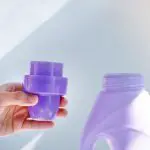Are you wondering if you can use liquid fabric softener on your beloved wool garments? Look no further! This article will provide you with all the information you need to make an informed decision.
We’ll delve into the properties of wool and explore the effects of liquid fabric softeners on this delicate material.
Additionally, we’ll discuss alternative methods to soften wool and offer precautions to keep in mind.
Get ready to discover the best ways to maintain your wool’s softness!
Table of Contents
The Properties of Wool
You can’t use liquid fabric softener on wool because it can damage the natural properties of the fabric. Wool fibers have unique characteristics that make them special. Understanding these properties is crucial in maintaining the quality and durability of wool garments.
Wool has natural elasticity, which allows it to stretch and return to its original shape. This property ensures that your woolen clothing remains wrinkle-free and retains its shape even after repeated use. Additionally, wool fibers have a high moisture absorption capacity, which helps in regulating body temperature. This means that wool keeps you warm in winter and cool in summer by wicking away moisture from your skin.
To preserve the benefits of using wool, it is essential to use a wool fabric softener specifically designed for this fabric. Wool fabric softeners are formulated to gently condition and nourish the fibers, keeping them soft and maintaining their natural properties. These specialized softeners also help in reducing static and preventing pilling, ensuring that your wool garments stay in excellent condition.
Understanding Liquid Fabric Softeners
If you’re wondering whether liquid fabric softener is compatible with wool, there are a few things to consider.
Wool is a delicate fabric that requires special care, and using liquid fabric softener may not be the best option.
However, there are alternative methods and products that can help soften and maintain the quality of your wool garments.
Wool Softener Compatibility
To maintain the quality and integrity of your wool garments, it’s important to ensure that the fabric softener you choose is compatible with wool. Not all fabric softeners are suitable for use on wool, as some contain ingredients that can damage the delicate fibers.
When looking for wool softener brands, make sure to check the label for compatibility with wool. Look for fabric softeners that are specifically formulated for use on wool or that mention being safe for use on all fabrics, including wool.
Avoid fabric softeners that contain enzymes, bleach, or strong chemicals, as these can cause damage to wool fibers. Opt for gentle, wool-friendly fabric softeners that will keep your wool garments soft and in great condition.
Alternatives for Wool
There are alternative options available for maintaining the quality and softness of your wool garments. If you prefer natural wool alternatives or want to try some DIY wool softening methods, here are a few options to consider:
| Method | Ingredients | Process |
|---|---|---|
| Vinegar Solution | 1 part white vinegar, 3 parts water | Soak the wool garment in the solution for 30 minutes, then rinse with water and air dry. |
| Hair conditioner | Any silicone-free hair conditioner | Dilute the conditioner with water, then apply to the wool garment. Let it sit for a few minutes before rinsing and air drying. |
| Epsom salt | 1 cup Epsom salt, warm water | Dissolve the Epsom salt in warm water, soak the wool garment for 15 minutes, then rinse and air dry. |
These methods offer a natural and cost-effective way to soften and maintain the quality of your wool garments without using liquid fabric softeners. Give them a try and see which one works best for you!
Potential Effects of Fabric Softeners on Wool
Using liquid fabric softener on wool can potentially have adverse effects. Fabric softeners contain chemicals that can break down the natural fibers of wool, leading to shrinkage, loss of shape, and damage to the fabric.
Wool is a delicate material that requires special care to maintain its quality and longevity. When it comes to fabric softeners, it is important to take precautions when using them on wool garments.
Firstly, always read the care label on your wool item before using any fabric softener. Some wool garments may explicitly state that fabric softeners should not be used.
Secondly, if you do choose to use fabric softener on wool, dilute it with water before applying it to the garment. This will help reduce the concentration of chemicals and minimize potential damage.
Additionally, consider using a fabric softener specifically formulated for wool, as these products are designed to be gentler on delicate fabrics.
Alternative Ways to Soften Wool
Consider exploring alternative methods for softening wool, such as using a vinegar solution or gently hand washing with a mild detergent. These alternative wool treatments can help maintain the softness of your wool garments without the potential risks associated with using liquid fabric softener.
To test fabric softeners on wool, start by diluting a small amount of the fabric softener in water. Then, apply the solution to a small, inconspicuous area of the wool fabric, such as an inside seam. Gently rub the fabric together to see if any damage or discoloration occurs. If there are no adverse effects, proceed to apply the fabric softener to the entire garment according to the product’s instructions.
Remember to always hand wash your wool items, as machine washing can cause shrinkage and damage. After washing, reshape the garment and lay it flat to dry, avoiding direct sunlight or heat sources.
Precautions When Using Fabric Softeners on Wool
When it comes to softening wool, it’s important to consider the compatibility of fabric softeners with this delicate material. Some fabric softeners may not be suitable for use on wool, as they can cause damage or alter the texture of the fibers.
It’s also worth exploring alternative treatments that can achieve softness without the potential negative effects of fabric softeners.
Wool Compatibility With Softeners?
To determine if liquid fabric softener is safe for your wool garments, check the care label or consult a professional. While some people may choose to use fabric softeners on their wool items, it is important to consider the potential risks and alternatives. Here are four key points to keep in mind:
-
Care label instructions: Always follow the care instructions provided by the manufacturer. If the label advises against using fabric softeners, it is best to avoid them.
-
Gentler alternatives: Wool softeners specifically designed for wool garments are available. These products are formulated to be gentle on wool fibers and can help maintain their softness without causing damage.
-
Natural softening methods: Consider using natural methods to soften your wool garments, such as air-drying, steam, or using a vinegar solution during the rinse cycle.
-
Spot test: Before applying any fabric softener to your wool garment, perform a spot test on a small, inconspicuous area to ensure it does not cause any adverse effects.
Effects of Softeners?
The effects of using fabric softeners on wool garments should be carefully considered and understood before applying them. While fabric softeners can make your clothes feel softer and reduce static cling, they may not be compatible with wool.
Wool is a delicate fabric that requires special care to maintain its natural properties. Using fabric softeners on wool can cause the fibers to become coated and lose their natural ability to regulate temperature and moisture. It can also lead to pilling and reduce the lifespan of your wool garments.
Instead of using fabric softeners, it is recommended to opt for gentle detergents specifically designed for wool or use natural alternatives like vinegar or baking soda to soften your wool items.
Alternative Wool Treatments?
For a natural and effective way to soften your wool garments, consider using vinegar or baking soda as alternative treatments. These natural ingredients offer several benefits when used as wool softeners.
Vinegar, for example, helps to remove any residue left behind by detergents or other cleaning products, leaving your wool garments feeling soft and fresh. It also helps to restore the pH balance of the wool, making it less prone to becoming stiff and scratchy.
Baking soda, on the other hand, acts as a gentle exfoliant, removing any build-up of dirt or oils that may be causing your wool to feel coarse.
Additionally, both vinegar and baking soda are eco-friendly options that are safe for both you and the environment.
So why not give these alternative wool treatments a try and see the benefits for yourself?
How to Test Fabric Softeners on Wool
You can easily test fabric softeners on wool by following these steps:
-
Choose a small piece of wool fabric for testing, preferably from an inconspicuous area of the garment.
-
Prepare a solution of fabric softener according to the manufacturer’s instructions.
-
Dip a corner of the wool fabric into the fabric softener solution and gently squeeze out any excess liquid.
-
Allow the fabric to air dry completely.
-
Once dry, evaluate the softness and texture of the fabric to determine the effectiveness of the fabric softener on wool.
Testing methods for fabric softeners on wool can vary, but this simple method allows you to assess the softening capabilities of the product without risking damage to your woolen items.
Wool is a delicate material that requires special care, so it is important to test fabric softeners before using them on your favorite wool garments.
Wool softening techniques can vary, and not all fabric softeners are suitable for use on wool. By testing fabric softeners on a small piece of wool fabric, you can determine whether the product will enhance the softness of your woolen items or potentially cause damage.
Remember to always read and follow the instructions provided by the fabric softener manufacturer to ensure the best results.
Tips for Maintaining Wool’s Softness
To maintain the softness of wool, it’s important to handle and store it properly.
Wool is a delicate fabric that requires special care to retain its softness. First and foremost, avoid using liquid fabric softeners on wool. Fabric softeners can leave a residue on the fibers and make the wool stiff and less soft. Instead, opt for gentle detergents specifically designed for wool, as they will clean the fabric without compromising its softness.
When washing wool, always use cold water and avoid excessive agitation. This will help to prevent felting, which can make the fabric lose its softness and become rough. After washing, gently squeeze out excess water and avoid wringing or twisting the wool, as this can damage the fibers.
When drying, never hang woolen garments, as this can stretch them out of shape. Instead, lay them flat on a clean towel and reshape them while they dry.
Conclusion: Making an Informed Decision
In conclusion, it’s essential to make an informed decision when it comes to caring for your wool garments in order to maintain their softness and longevity.
When it comes to maintaining wool’s softness, there are a few things to consider. First, avoid using liquid fabric softener on wool. While it may seem like a convenient option, liquid fabric softener can actually damage the natural fibers of the wool, causing them to become stiff and lose their softness. Instead, opt for a wool-specific detergent or a gentle, pH-neutral soap. These products are specially formulated to clean wool without compromising its softness.
Additionally, it’s important to follow the care instructions on the garment’s label. This will ensure that you are using the correct temperature and washing method for your wool item.
Lastly, always air dry your wool garments instead of using a dryer. The heat from the dryer can cause the wool fibers to shrink and lose their softness.
Conclusion
In conclusion, it is best to proceed with caution when using liquid fabric softener on wool. Fabric softeners can provide a soft and fluffy feel to other fabrics, but they can potentially damage and shrink wool fibers. It is recommended to explore alternative methods, such as using a wool-specific fabric softener or simply air-drying and gently brushing the wool. By taking these precautions and being mindful of the care instructions, you can maintain the softness and longevity of your wool garments.
- How Does Ring Spun Cotton Affect Garment Fit and Shape Retention? - August 13, 2024
- What Are the Challenges in Producing Ring Spun Cotton? - August 13, 2024
- Is Ring Spun Cotton Suitable for Plus-Size Clothing? - August 13, 2024





